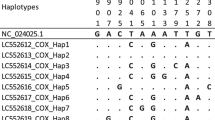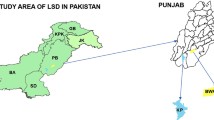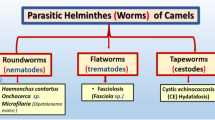Abstract
To reveal the genetic diversity of Babesia microti and Theileria orientalis in Southwest China, we conducted a molecular survey of piroplasms in hard ticks in a China-Myanmar border county. Host infesting and questing ticks were collected from Tengchong County in 2013 and 2014. Piroplasm infection in ticks was detected by PCR, and then, phylogenetic analysis was conducted to study the genetic diversity of the pathogens identified in ticks. All in all, six piroplasm species comprising of B. microti; B. orientalis; a novel Babesia species designated Babesia sp. Tengchong, China; T. orientalis; T. luwenshuni; and an as yet undescribed piroplasmid species referred to as Piroplasmid sp. Tengchong, China, have been identified after screening goat- and cattle-attached ticks. In addition, B. bigemina has been identified by screening questing ticks. Phylogenetic analysis based on the 18S rRNA and partial β-tubulin gene revealed two novel potentially zoonotic genotypes designated B. microti Tengchong-Type A and B. The T. orientalis genotypes identified in the present study represent the seven known genotypes 1–5, 7, and N3 as revealed by phylogenetic analysis of 18S rRNA and MPSP genes. Importantly, an additional genotype designated N4 has also been identified in this study, which brings the number of recognized T. orientalis genotypes to a total of twelve. Thus, besides the two novel species, Babesia sp. Tengchong, China, closely related to Babesia species isolated from yak and Piroplasmid sp. Tengchong, China, our study demonstrates that additional novel B. microti and T. orientalis genotypes exist in Southwest China.





Similar content being viewed by others
References
Antunes S, Rosa C, Couto J, Ferrolho J, Domingos A (2017) Deciphering Babesia-vector interactions. Front Cell Infect Microbiol 7:429. https://doi.org/10.3389/fcimb.2017.00429
Baneth G, Florin-Christensen M, Cardoso L, Schnittger L (2015) Reclassification of Theileria annae as Babesia vulpes sp. nov. Parasit Vectors 8:207. https://doi.org/10.1186/s13071-015-0830-5
Baneth G, Cardoso L, Brilhante-Simoes P, Schnittger L (2019) Establishment of Babesia vulpes n. sp. (Apicomplexa: Babesiidae), a piroplasmid species pathogenic for domestic dogs. Parasit Vectors 12:129. https://doi.org/10.1186/s13071-019-3385-z
Bawm S, Shimizu K, Hirota J, Tosa Y, Htun LL, Maw NN, Thein M, Kato H, Sakurai T, Katakura K (2014) Molecular prevalence and genetic diversity of bovine Theileria orientalis in Myanmar. Parasitol Int 63:640–645. https://doi.org/10.1016/j.parint.2014.04.009
Bloch EM et al (2018) A pilot serosurvey of Babesia microti in Chinese blood donors. Vox Sang 113:345–349. https://doi.org/10.1111/vox.12648
Chen Z, Li H, Gao X, Bian A, Yan H, Kong D, Liu X (2019) Human Babesiosis in China: a systematic review. Parasitol Res 118:1103–1112. https://doi.org/10.1007/s00436-019-06250-9
Gao ZH, Huang TH, Jiang BG, Jia N, Liu ZX, Shao ZT, Jiang RR, Liu HB, Wei R, Li YQ, Yao HW, von Fricken M, Jiang JF, du CH, Cao WC (2017) Wide distribution and genetic diversity of Babesia microti in small mammals from Yunnan Province, southwestern China. PLoS Negl Trop Dis 11:e0005898. https://doi.org/10.1371/journal.pntd.0005898
Goethert HK, Telford SR (2003) What is Babesia microti? Parasitology 127:301–309
Homer MJ, Aguilar-Delfin I, Telford SR 3rd, Krause PJ, Persing DH (2000) Babesiosis. Clin Microbiol Rev 13:451–469. https://doi.org/10.1128/cmr.13.3.451-469.2000
Jalovecka M, Sojka D, Ascencio M, Schnittger L (2019) Babesia life cycle - when phylogeny meets biology. Trends Parasitol 35:356–368. https://doi.org/10.1016/j.pt.2019.01.007
Jongejan F, Uilenberg G (2004) The global importance of ticks. Parasitology 129(Suppl):S3–S14. https://doi.org/10.1017/S0031182004005967
Kamau J, de Vos AJ, Playford M, Salim B, Kinyanjui P, Sugimoto C (2011) Emergence of new types of Theileria orientalis in Australian cattle and possible cause of theileriosis outbreaks. Parasit Vectors 4:22. https://doi.org/10.1186/1756-3305-4-22
Kim JY, Cho SH, Joo HN, Tsuji M, Cho SR, Park IJ, Chung GT, Ju JW, Cheun HI, Lee HW, Lee YH, Kim TS (2007) First case of human babesiosis in Korea: detection and characterization of a novel type of Babesia sp. (KO1) similar to ovine babesia. J Clin Microbiol 45:2084–2087. https://doi.org/10.1128/JCM.01334-06
Kumar S, Tamura K, Nei M (1994) MEGA: molecular evolutionary genetics analysis software for microcomputers. Comput Appl Biosci 10:189–191. https://doi.org/10.1093/bioinformatics/10.2.189
Li LH, Zhu D, Zhang CC, Zhang Y, Zhou XN (2016) Experimental transmission of Babesia microti by Rhipicephalus haemaphysaloides. Parasit Vectors 9:231–236. https://doi.org/10.1186/s13071-016-1517-2
Li LH, Zhang Y, Wang JZ, Li XS, Yin SQ, Zhu D, Xue JB, Li SG (2018) High genetic diversity in hard ticks from a China-Myanmar border county. Parasit Vectors 11:469. https://doi.org/10.1186/s13071-018-3048-5
Mans BJ, Pienaar R, Latif AA (2015) A review of Theileria diagnostics and epidemiology. Int J Parasitol Parasites Wildl 4:104–118. https://doi.org/10.1016/j.ijppaw.2014.12.006
Mansfield KL, Jizhou L, Phipps LP, Johnson N (2017) Emerging tick-borne viruses in the twenty-first century. Front Cell Infect Microbiol 7:298. https://doi.org/10.3389/fcimb.2017.00298
Moritz ED, Winton CS, Tonnetti L, Townsend RL, Berardi VP, Hewins ME, Weeks KE, Dodd RY, Stramer SL (2016) Screening for Babesia microti in the U.S. blood supply. N Engl J Med 375:2236–2245. https://doi.org/10.1056/NEJMoa1600897
Nei M, Kumar S (2000) Molecular evolution and Phylogenetics. Oxford University Press, New York
Ota N, Mizuno D, Kuboki N, Igarashi I, Nakamura Y, Yamashina H, Hanzaike T, Fujii K, Onoe S, Hata H, Kondo S, Matsui S, Koga M, Matsumoto K, Inokuma H, Yokoyama N (2009) Epidemiological survey of Theileria orientalis infection in grazing cattle in the eastern part of Hokkaido, Japan. J Vet Med Sci 71:937–944. https://doi.org/10.1292/jvms.71.937
Qi M, Cui Y, Song X, Zhao A, Bo J, Zheng M, Ning C, Tao D (2018) Common occurrence of Theileria annulata and the first report of T. ovis in dairy cattle from southern Xinjiang, China. Ticks Tick Borne Dis 9:1446–1450. https://doi.org/10.1016/j.ttbdis.2018.06.017
Qin G, Li Y, Liu J, Liu Z, Yang J, Zhang L, Liu G, Guan G, Luo J, Yin H (2016) Molecular detection and characterization of Theileria infection in cattle and yaks from Tibet plateau region, China. Parasitol Res 115:2647–2652. https://doi.org/10.1007/s00436-016-5011-8
Rehman K, Bettani MAK, Veletzky L, Afridi S, Ramharter M (2018) Outbreak of Crimean-Congo haemorrhagic fever with atypical clinical presentation in the Karak District of Khyber Pakhtunkhwa, Pakistan. Infect Dis Poverty 7:116. https://doi.org/10.1186/s40249-018-0499-z
Saito-Ito A, Yano Y, Dantrakool A, Hashimoto T, Takada N (2004) Survey of rodents and ticks in human babesiosis emergence area in Japan: first detection of Babesia microti-like parasites in Ixodes ovatus. J Clin Microbiol 42:2268–2270. https://doi.org/10.1128/JCM.42.5.2268-2270.2004
Schnittger L, Rodriguez AE, Florin-Christensen M, Morrison DA (2012) Babesia: a world emerging. Infect Genet Evol 12:1788–1809. https://doi.org/10.1016/j.meegid.2012.07.004
Sivakumar T, Hayashida K, Sugimoto C, Yokoyama N (2014) Evolution and genetic diversity of Theileria. Infect Genet Evol 27:250–263. https://doi.org/10.1016/j.meegid.2014.07.013
Vannier E, Krause PJ (2012) Human babesiosis. N Engl J Med 366:2397–2407. https://doi.org/10.1056/NEJMra1202018
Vannier E, Krause PJ (2015) Babesiosis in China, an emerging threat. Lancet Infect Dis 15:137–139. https://doi.org/10.1016/S1473-3099(14)71062-X
Wang J, Yang J, Liu J, Wang X, Xu J, Liu A, Li Y, Liu Z, Ren Q, Luo J, Guan G, Yin H (2018) Molecular detection and genetic diversity of Theileria orientalis in cattle in China. Parasitol Res 117:3689–3694. https://doi.org/10.1007/s00436-018-6023-3
Wu J, Cao J, Zhou Y, Zhang H, Gong H, Zhou J (2017) Evaluation on infectivity of Babesia microti to domestic animals and ticks outside the Ixodes genus. Front Microbiol 8:1915. https://doi.org/10.3389/fmicb.2017.01915
Zamoto-Niikura A, Tsuji M, Qiang W, Nakao M, Hirata H, Ishihara C (2012) Detection of two zoonotic Babesia microti lineages, the Hobetsu and U.S. lineages, in two sympatric tick species, Ixodes ovatus and Ixodes persulcatus, respectively, in Japan. Appl Environ Microbiol 78:3424–3430. https://doi.org/10.1128/AEM.00142-12
Zamoto-Niikura A, Tsuji M, Qiang W, Morikawa S, Hanaki KI, Holman PJ, Ishihara C (2018) The Babesia divergens Asia lineage is maintained through enzootic cycles between Ixodes persulcatus and Sika deer in Hokkaido, Japan. Appl Environ Microbiol 84:e02491–e02417. https://doi.org/10.1128/AEM.02491-17
Zhou X, Li SG, Chen SB, Wang JZ, Xu B, Zhou HJ, Ge HX, Chen JH, Hu W (2013) Co-infections with Babesia microti and Plasmodium parasites along the China-Myanmar border. Infect Dis Poverty 2:24. https://doi.org/10.1186/2049-9957-2-24
Zhou X, Xia S, Huang JL, Tambo E, Zhuge HX, Zhou XN (2014) Human babesiosis, an emerging tick-borne disease in the People's Republic of China. Parasit Vectors 7:509–510. https://doi.org/10.1186/s13071-014-0509-3
Zhou Y, Zhang H, Cao J, Gong H, Zhou J (2016) Epidemiology of toxoplasmosis: role of the tick Haemaphysalis longicornis. Infect Dis Poverty 5:14. https://doi.org/10.1186/s40249-016-0106-0
Zhuang L, du J, Cui XM, Li H, Tang F, Zhang PH, Hu JG, Tong YG, Feng ZC, Liu W (2018) Identification of tick-borne pathogen diversity by metagenomic analysis in Haemaphysalis longicornis from Xinyang, China. Infect Dis Poverty 7:45–48. https://doi.org/10.1186/s40249-018-0417-4
Funding
This work was partially supported by the Special Fund for Basic Resources in Science and Technology (no. 2017FY101203), the National Key Research and Development Program of China (nos. 2016YFC1200500 and 2016YFC1202001), the fourth round of the Three-Year Public Health Action Plan (no. GWIV-29), Shandong Provincial Natural Science Foundation (no. ZR2019MH093), and National Natural Science Foundation of China (no. 81902095).
Author information
Authors and Affiliations
Contributions
LHL designed the investigation, performed the experiments and drafted the manuscript. JZW, DZ, XSL, SQY, and ZGL conducted the field investigation. YL performed the experiments and data analysis. YZ and XNZ conceived the study and revised the manuscript. All authors read and approved the final manuscript.
Corresponding author
Ethics declarations
Competing interests
The authors declare that they have no competing interests.
Ethics statement
No specific permits were required for this study. The study did not involve endangered or protected species. Therefore, the local ethics committee deemed approval unnecessary.
Additional information
Section Editor: Leonhard Schnittger
Publisher’s note
Springer Nature remains neutral with regard to jurisdictional claims in published maps and institutional affiliations.
Electronic supplementary material
ESM 1
(XLSX 32 kb)
Rights and permissions
About this article
Cite this article
Li, LH., Wang, JZ., Zhu, D. et al. Detection of novel piroplasmid species and Babesia microti and Theileria orientalis genotypes in hard ticks from Tengchong County, Southwest China. Parasitol Res 119, 1259–1269 (2020). https://doi.org/10.1007/s00436-020-06622-6
Received:
Accepted:
Published:
Issue Date:
DOI: https://doi.org/10.1007/s00436-020-06622-6




